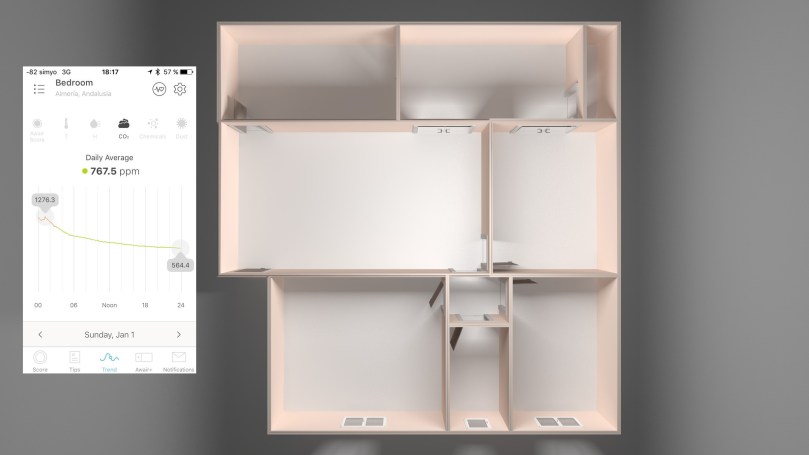
Both devices are equipped almost with the same home-environment sensors.
- CO2 sensor: Awair | AirVisual Node
- Particular Matter sensor: Awair | AirVisual Nod
- Temperature sensor: Awair | AirVisual Node
- Humidity sensor: Awair | AirVisual Node
- VOCs sensor: Awair
Carbon Dioxide:
Both devices have a dedicated sensor for the CO2, they use a different brand but they are equally well. AirVisual Node is equipped with the SenseAir S8 Sensor. Awair is equipped with the Telaire 6703 Sensor. Both are expensive and accurate and both devices display the CO2 in parts per million (ppm) values. They always measure the same values.
Particular Matter:
AirVisual Node uses the AVPM25b sensor which AirVisual own and co-developed. Awair uses a “generic” sensor by Sharp GP2Y10. Sharp’s sensor isn’t accurate at all in my opinion through my experience but the AVPM25b is very good and uses a small fan to draw air inside which produces a low sound noise. Both measure in μg/m³.
Temperature/ Humidity:
I had the devices side by side for a long time and they always had the same indications for temperature and humidity. However the AirVisual Node used to show an exact +10% offset in Humidity measurements, for example when Awair (and two more humidity instruments) indicated RH:51% the AirVisual Node indicated RH:61% and so on, but they updated the firmware and the offset is now fixed.
Volatile Compounds:
Awair is the only device which features a VOC sensor. Some people find value on it so it’s nice to have it if you need it. It measures in ppb. To be honest I don’t trust the VOC sensors in general and you can read the reason on this post: My opinion about VOC Sensors.
Connectivity:
Awair features WiFi and Bluetooth (BT for the initial set up) and they finally fixed the connectivity issue they were running into that caused the device to disconnect from the internet. Awair also features IFTTT, Alexa and Nest connectivity. AirVisual Node features only WiFi but they offer the off-the-grid ability in which the device stores the measurement in a .csv file and you can have access to it via SMB later, read more on the Complete Review: AirVisual Node. The Node is powered and charged via a micro USB port but the Awair uses a connector like the old Nokia phones which is a bit uncommon nowadays.
UI/UX/Design:
Both devices have a unique interface. The Awair allows browsing the air quality history up to a week and the AirVisual Node has an unlimited air quality history. Personally I prefer the charts from the Awair UI which are curved lines, the Node uses columns (question of taste). As a physical device Awair offers a modern with clean lines design and AirVisual Node a futuristic more curved one. Finally the Node has a 5-inch colour display in front which offers a lot of information (Local and/or Remote) and Awair has a dot matrix display which is more discreet.

Conclusion/Suggestions:
All in all both devices are well built in the majority of the sensors. I like both of them they have a great design and great software. I feel that the Node has got some unique features for the advanced users and Awair offers an easy and friendly experience for the average user. Awair please you have to consider allowing the device to function without internet in the future. AirVisual please the app and the widget are missing the value (μg/m³) of the PM2.5, it appears on the device but neither on the app nor the widget except the US/China AQI values.
Thank you





